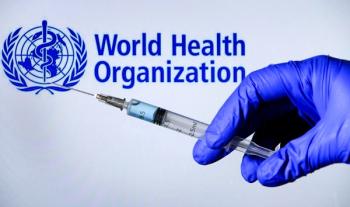
Bronchoalveolar Carcinoma in a 58-Year-Old Man
A 58-year-old man presents with exertionaldyspnea of 6 weeks’ duration, adry cough for 2 weeks, and decreasedappetite. He denies fever, chills, sputumproduction, hemoptysis, cigarette smoking,and significant weight loss. Thepatient, a retired electrician, was exposedto asbestos 20 years earlier.
A 58-year-old man presents with exertional dyspnea of 6 weeks' duration, a dry cough for 2 weeks, and decreased appetite. He denies fever, chills, sputum production, hemoptysis, cigarette smoking, and significant weight loss. The patient, a retired electrician, was exposed to asbestos 20 years earlier. The patient is in no respiratory distress at rest. His temperature is 37.2°C (99°F); heart rate, 68 beats per minute; respiration rate, 16 breaths per minute; and blood pressure, 120/75 mm Hg. The skin and mucosa are normal. Posterior bilateral symmetric rales are heard most prominently in the subscapular areas. There is normal resonance to percussion; no wheezing is detected. Cardiovascular and abdominal examinations are unremarkable; no lymphadenopathy is noted. Spirometry demonstrates a severe restrictive pattern. Oxygen saturation at rest is 96% on room air. Complete blood cell count with differential and erythrocyte sedimentation rate (ESR) are normal; levels of all blood chemistry components, including lactate dehydrogenase, thyrotropin, and angiotensin-converting enzyme (ACE), are within normal limits. Chest films reveal bilateral multilobular interstitial opacifications with a few air bronchograms in the right lower lobe (Figure 1). Central lymphadenopathy and pleural effusions are absent. The nonspecific clinical presentation, abnormal spirometry results, and highly suspicious radiologic findings suggest a bronchoalveolar carcinoma. A CT scan with contrast of the chest reveals a pattern of widespread micronodular air-space lesions with a 1-cm speculated nodule in the posterior left upper lobe (Figure 2). Diffuse bilateral bronchovascular thickening and increased reticular markings suggest contiguous lymphangitic spread. A transbronchial biopsy confirms the diagnosis of bronchoalveolar carcinoma. Despite aggressive chemotherapy with taxol and carboplatin, the patient dies 6 months after diagnosis.
OVERVIEW
Bronchoalveolar carcinoma is a primary malignant pulmonary neoplasm that accounts for 2% to 14% of all pulmonary malignancies.1 It was first described by Malassez2 in 1876.
Pathogenesis
The type II pneumocyte had been thought to be the cell of origin. Recently, however, Clara cells alone or mixed with other cells, such as endocervical mucinous or colonic mucinous cells, have been found3,4; this suggests a multicentric origin of the malignancy.4 A pure bronchoalveolar cell pattern, which carries a poor prognosis, is rarely seen; a mixture of adenocarcinoma and more dominant bronchoalveolar carcinoma is more common.
Classification
According to the World Health Organization classification, bronchoalveolar carcinoma is a subtype of adenocarcinoma and is characterized by3,5:
- No evidence of any extrathoracic adenocarcinoma.
- Absence of a central bronchogenic source.
- Peripheral parenchymal location.
- Aerogenous spread along the alveolar septa, conserving the alveolar framework.
Bronchoalveolar carcinoma may be thought of as 2 distinct entities-radiologic focal and radiologic diffuse forms-with a common histology.6 The radiologic focal form, which comprises 40% to 80% of cases,4,6 is amenable to surgical cure; therefore, patients with focal disease have a better prognosis than those with other lung malignancies. Overall, more than two-thirds of affected persons who have received treatment are alive at 5 years; at 10 years, half of these patients are alive.4 The radiologic diffuse form of the disease includes both multinodular and infiltrative pneumonic presentations. Approximately 30% of patients with unilateral-and thus, resectable-diffuse disease are alive after 5 years; virtually none of those with bilateral lesions survive.6
Epidemiology
Compared with other pulmonary malignancies, bronchoalveolar carcinoma is more prevalent in women and in nonsmokers and occurs more frequently in the right lung.4,6 Smoking nonetheless is a risk factor.
Presentation and diagnosis
Cough, hemoptysis, dyspnea, chest pain, and weight loss are the most common symptoms.4,7 There is little correlation between symptoms, smoking status, and the radiologic findings. Because of the peripheral location of the tumor, the diagnosis frequently is made by surgical resection; however, fine-needle aspiration, bronchoscopy, and sputum cytology may be useful.
DIFFERENTIAL DIAGNOSIS
The differential diagnosis of a diffuse interstitial lung disease is broad and includes asbestosis; fungal infection; eosinophilic pneumonia; and connective tissue disorders, such as rheumatoid arthritis.7 Clinical and paraclinical findings help narrow the differential. This patient's chest films showed no pleural involvement characteristic of asbestosis. Between 5% and 10% of asbestos-exposed patients experience disease progression after exposure to the carcinogen has ceased; most of this damage occurs during the 5 years that immediately follow exposure.8 The likelihood of a fungal infection is small in an immunocompetent patient without fever or productive cough or a history of travel to areas where these infections are endemic. Histoplasmosis, for example, is endemic to the Ohio and Mississippi river valleys. The persistent lack of eosinophils in the manual differential count ruled out eosinophilic pneumonia. Although persons with mild rheumatoid arthritis may have lung fibrosis of varying severity, the absence of multisystem involvement and the normal ESR in this patient excluded a connective tissue disorder. Sarcoidosis usually is associated with fever, lymphadenopathy, skin lesions, and an elevated ACE level.8 Neither this patient's age nor his clinical presentation was typical of persons with idiopathic pulmonary hemosiderosis or lymphocytic interstitial pneumonia. These diseases occur more commonly in children and young adults. Other diagnostic considerations are histiocytosis X, or Langerhans cell granulomatosis; idiopathic pulmonary fibrosis; pulmonary alveolar proteinosis; and bronchiolitis obliterans organizing pneumonia (BOOP). Both histiocytosis X and idiopathic pulmonary fibrosis are characterized by a restrictive pattern on spirometry and a radiologic appearance known as “honeycombing.” Elevations in ESR and lactate dehydrogenase and gamma globulin levels are associated with both idiopathic pulmonary fibrosis and alveolar proteinosis. Radiologic findings in patients with alveolar proteinosis resemble those seen in patients with pulmonary edema: for example, a butterfly pattern of opacities with no enlargement of the hilar lymph nodes.8 Typical features of BOOP include leukocytosis, an elevated ESR, a restrictive pattern on spirometry, and hypoxia.8 The course of this disease is self-limited and typically lasts for less than 2 to 3 months without treatment.
TREATMENT
The treatment of choice is complete resection of the tumor; segmentectomy or lobectomy affords the best results.6 Because disease recurrence is not uncommon after wedge resection of a peripheral solitary lesion, this technique may not be a prudent choice. Lobectomy or pneumectomy can be tried in patients with diffuse unilateral disease, despite a less positive outcome than when used for resection of nodal forms of the carcinoma.4,6 Chemotherapy and radiation therapy are ineffective in the approximately 10% to 30% of patients with bronchoalveolar carcinoma who have inoperable disease. The progress of the disease in these patients is rapid and uncontrollable4,6; the lymphogenic spread of the tumor is facilitated by the tearing of the basement membrane by the type IV collagenase activity of the malignant cells.4 After surgery, monitor patients with periodic chest films and CT scans for tumor recurrence. The Table lists the prognostic factors associated with longer survival. Relapse occurs in about 40% of surgically treated patients; the disease recurs in focal form in only about 20% of these patients, for whom a second resection is warranted.
References:
REFERENCES:1. Regnard JF, Santelmo N, Romdhani N, et al. Bronchioloalveolar lung carcinoma: results of surgical treatment and prognostic factors. Chest. 1998;114:45-50.
2. Malassez L. Examen histologique d’un cas de cancer encephaloide du poumon (epithelioma). Arch Physiol Norm Pathol. 1876;3:353-372.
3. Liebow AA. Bronchioloalveolar carcinoma. Adv Intern Med. 1960;10:329-358.
4. Okubo K, Mark EJ, Flieder D, et al. Bronchoalveolar carcinoma: clinical, radiologic, and pathologic factors and survival. J Thorac Cardiovasc Surg. 1999;118:702-709.
5. The World Health Organization histological typing of lung tumours. 2nd ed. Am J Clin Pathol. 1982;77:123-136.
6. Liu YY, Chen YM, Huang MH, Perng RP. Prognosis and recurrent patterns in bronchioloalveolar carcinoma. Chest. 2000;118:940-947.
7. Goroll AH, Mulley AG, eds. Primary Care Medicine: Office Evaluation and Management of the Adult Patient. 4th ed. Philadelphia: Lippincott Williams & Wilkins; 2000:330-332.
8. Beers MH, Berkow R. The Merck Manual of Diagnosis and Therapy. 17th ed. Whitehouse Station, NJ: Merck Research Laboratories; 1999:619-642.
Newsletter
Enhance your clinical practice with the Patient Care newsletter, offering the latest evidence-based guidelines, diagnostic insights, and treatment strategies for primary care physicians.






















































































































































































































































































